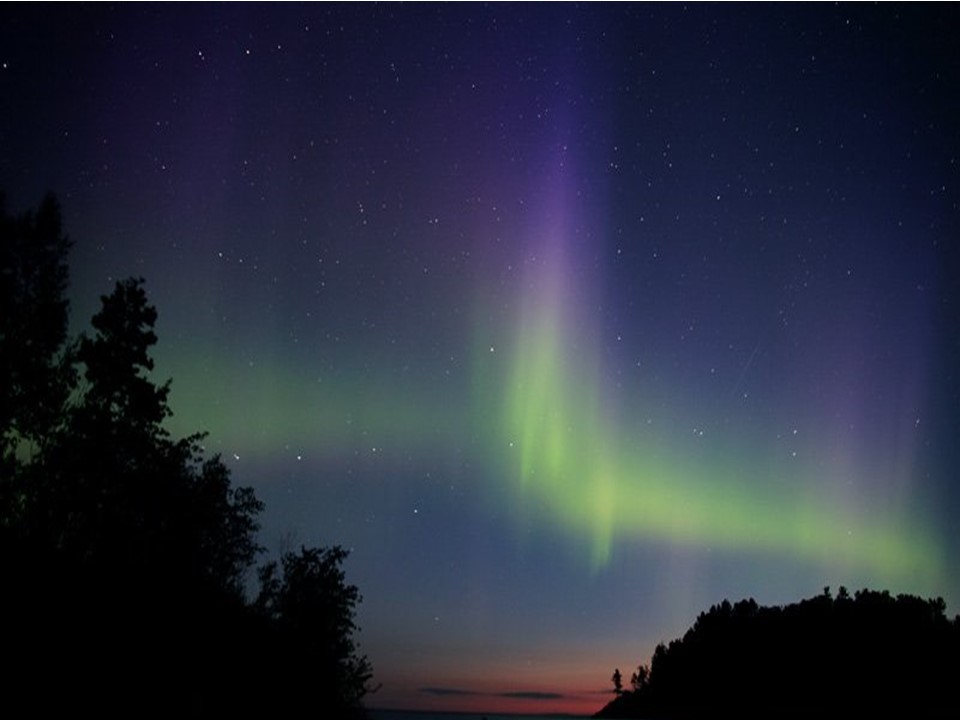[Update: Fri., May 10, 2024, 1:30pm] More information about the severe solar storm headed toward Earth came from the Space Weather Prediction Center (SWPC) on Friday morning. The Sun, 93 million miles away, began emitting magnetic energy in our direction when a giant sunspot cluster began flaring on Wednesday morning. At about one million miles from earth, or around 5 p.m. today in California, after being buffeted by solar winds, the storm may begin to show scientists an arrival time and how it might affect the Earth and the technology we all rely upon.
What is most likely to form is a glowing aurora from the collision of the solar wind and the ionosphere around the polar regions of our planet. In the Northern Hemisphere, it will be most visible down to Northern California, said Shawn Diehl, a forecaster with SWPC — pronounced “Swip-see.” In previous events, an aurora was visible on photographs made as far south as Central America, South Texas, and Hawai’i. “If you have a clear night sky, free of bright lights, no clouds, try taking a photo with your cell phone,” suggested Rob Steenburgh, a scientist with SWPC, “and you may see some impressive aurora displays.”
As for the likely effects on the third planet from the Sun, the key will be whether the magnetic field accompanying the solar cloud will be oriented north or south. Diehl likened it to common magnets and their traits of attraction — north to south — and repulsion — same to same. The “coronal mass ejections” propelling the solar storm have a magnetic orientation that will be unknown until it comes closer, Diehl explained. If attractive to the Earth’s magnetic field, there would be larger effects. Among those are:
• satellite disruption, which could affect GPS systems, aviation, and communications
• effects on transmission lines as they encounter the DC current from the storm and trip breakers
• effects on pipelines and railroad tracks, which can attract current as potential and lengthy metallic conductors of electricity
The atmosphere around the Earth shields the planet from the particles descending from the solar cloud streaming from the Sun. Astronauts aboard the space station may need to seek the most shielded parts of the station to avoid radiation, said Steenburgh, who had been on the team analyzing radiation at Johnson Space Center in Houston.
This is the first solar storm watch issued since 2005. Although three previous category G4 events have been observed since 2019, they were on the low end of the scale, unlike this one. The solar storm watch issued was to alert communications and grid providers to take preventive measures, the SWPC scientists said. More advance planning was an interest the government was taking, said Diehl, who said he was headed next to the Federal Emergency Management Agency “just in case.”
An Aurora Dashboard is tracking events and can be found here.

[Original Story] A sunspot cluster 16 times larger than the Earth has emitted five strong solar flares since May 8, with the “earth-directed coronal mass ejections” expected to affect communications and the power grid as early as mid-day Friday, May 10. The heads up came from NOAA’s Space Weather Prediction Center on Thursday.
The solar flares and high-speed coronal mass ejections combine to form a “geomagnetic storm” that is headed toward the Earth. The explosions of plasma and magnetic energy from the sun’s corona not only could affect communications and the power grid through Sunday, but they are expected to create “spectacular displays of aurora,” the National Weather Service stated, that might be seen as far south as Alabama and as far north as Northern California.
The geomagnetic storm is rated G4, or “severe.” A previous G4 event took place on March 23 of this year but adverse affects had not been expected, though warnings were made for satellite operations anomalies and GPS degradation.
A G5, or “extreme,” event took place in October 2003, dubbed the Halloween Storms, in which three massive and very intense sunspots, 13 times the size of Earth, blew out 17 major solar flares; one was the largest ever recorded. Though the Earth’s atmosphere shielded most of the effects, this one caused electrical outages in Sweden and damaged power transformers in South Africa, according to a recap by the National Oceanic and Atmospheric Administration.












You must be logged in to post a comment.